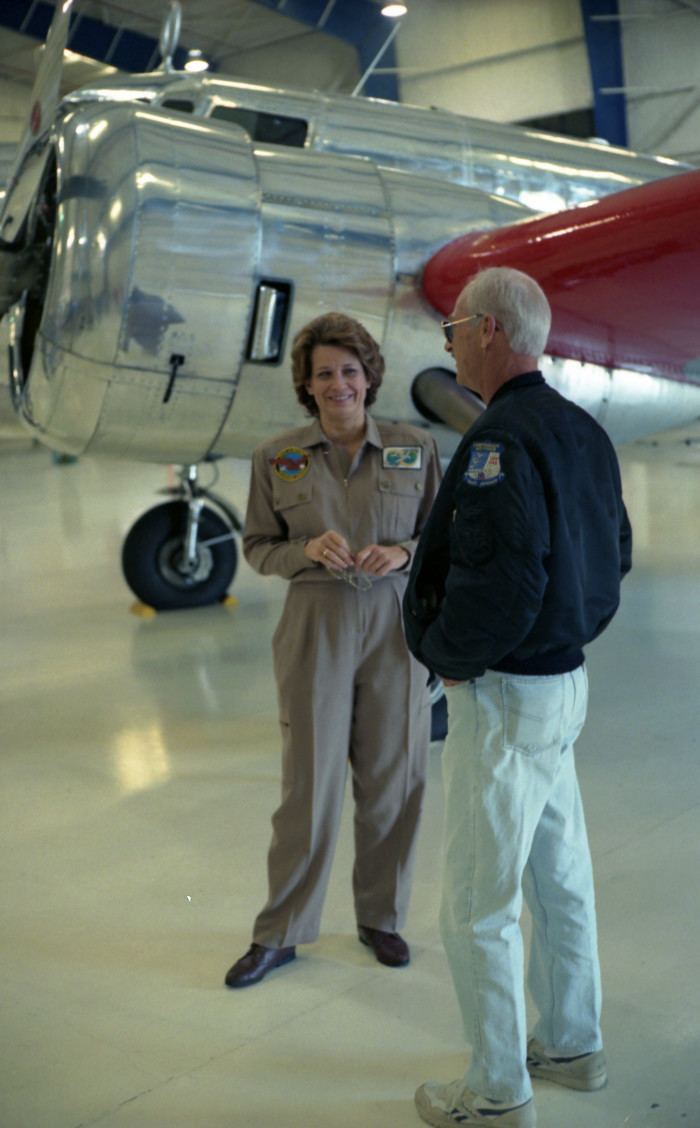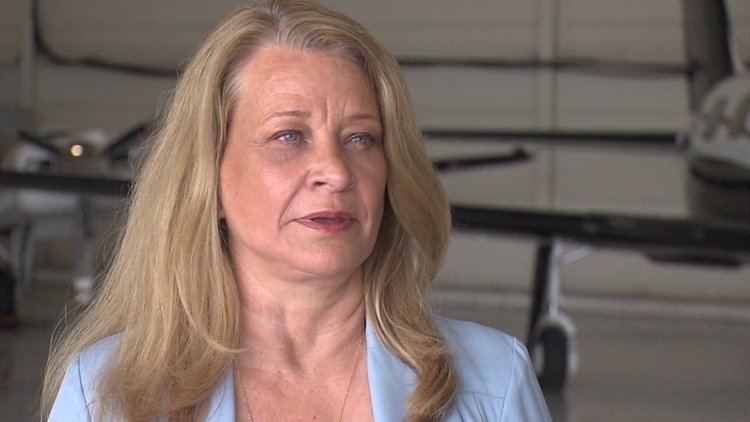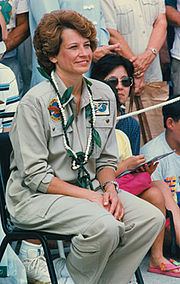Name Linda Finch | Role Aviator | |
 | ||
Occupation Aviator, businesswoman, author and spokesperson Known for Business and Aviation achievements | ||
Egypt linda finch arrives in her 1935 twin propeller aircraft
Linda Finch is an aviator and aviation historian born in San Antonio, Texas.
Contents
- Egypt linda finch arrives in her 1935 twin propeller aircraft
- Usa pilot linda finch completes successful round the world flight
- Aircraft career
- World Flight 1997
- Preparations
- Recreation of historic flight
- References

Usa pilot linda finch completes successful round the world flight
Aircraft career

During Finch’s early 20s she decided that she wanted to learn to fly a World War II F4U Corsair fighter aircraft. Whenever she could afford it she purchased flying and training lessons. Finch finally obtained her pilot's license in 1972. After graduating from a rented Grumman trainer in 1980 to her own Piper Arrow, Finch flew regularly to nursing homes that she managed throughout Texas. In her 30s, she bought a North American T-6 Texan, a wartime trainer which she completely restored, modified and raced, primarily to prepare her to fly the Corsair.
Early in her flying career, Finch joined the Confederate Air Force (now Commemorative Air Force) Association to acquire the flying skills necessary to handle warbirds, including the T-6 and Corsair. One difficult lesson to learn was how to land an AT-6 numerous times without power. This was taught to her so she would learn how the plane would handle in emergencies. Finch was the head coordinator and primary sponsor of the Commemorative Air Force Republic P-47D Thunderbolt "Tarheel Hal", (S/N: 44-90368, marked as 44-33240). She is a major fundraiser for the restoration and marketing of this rare aircraft, of which it is reported that there are only a small number still flying. She is also a licensed, trained pilot for this type of aircraft and assisted in maintenance and restoration.
Finch has logged more than 8,000 flying hours with approximately 5,900 of these flying hours in vintage multi-engine aircraft, warbirds and tail draggers. She has flown in numerous air shows around the world for more than 20 years.
World Flight 1997
Finch recreated the ill-fated last flight of Amelia Earhart. To fulfill Amelia Earhart's dream, the recreation of the 1937 around-the-world flight of Earhart was known as "World Flight 1997." Finch’s flight marked the 60th anniversary of Earhart's failed effort as well as centennial of her birth.
History records that Amelia Earhart was the first woman to fly solo across the Atlantic, the first woman to fly nonstop across the United States and first woman to fly from Hawaii to the west coast of California. The whole world was watching Amelia Earhart when she began her global attempt and of course then mourned her when the plane came up missing without a trace. Earhart was lost somewhere in the south Pacific Ocean. Finch hoped in her recreation of the Earhart circumnavigation, that children around the world would understand Earhart’s courage, hope and determination, and find heroes in their own lives - heroes that would teach them to also "reach for the sky".
Finch flew a restored 1935 Lockheed Electra 10E, the same make and model aircraft as Earhart on her last journey. Finch did this historic flight, and education and communication program with the help of a large team, provided by Pratt & Whitney. Hamilton Standard delivered the web site that hosted the first large educational internet program. Supplemental curriculum was provided to over 40,000 U.S. schools and schools around the world. More than 2.2 million children, women, and adults "flew with Linda" around the world on this grand adventure.
Preparations
The uniqueness of Finch’s flight is that it was done in a rare 1935 Electra 10E, restored to the specifications of Earhart's plane. Finch came up with the idea of recreating Earhart's flight in 1994 when she found the remains of one of only two flight-worthy Electra 10Es in existence. Finch came upon it stored in a hangar at a small grass strip airport near Chippewa Falls, Wisconsin where it had been sitting for years; the wings were off, the engines had been sold and various other parts were missing. Finch spent nearly every penny she had (a total of $330,000) to purchase the hulk and haul it back to her hometown in Texas. She set about restoring it with the help of a four and a half million dollar donation from aircraft engine manufacturer, Pratt & Whitney. This company designed and built the original Wasp radial engines that powered Amelia Earhart's Electra. Using original drawings and old vintage photographs, the 1935 aircraft was accurately restored right down to its rivets.
The Electra was methodically and meticulously put back together with great attention to original specifications. The only exception to the original is that Finch's Electra was equipped with modern navigation and communication equipment whereas Earhart's had primitive radio communications by today's standards. Finch’s aircraft was outfitted with a Global Positioning System for world navigation and tracking electronics as she hopped across the Atlantic Ocean and Pacific Ocean between the islands. Finch was never out of communications thanks to a laptop computer and satellite links. Amelia Earhart's communication and navigation problems in 1937 were far more challenging.
Finch’s Electra 10E was modified to carry approximately the same amount of fuel as Earhart. >
Recreation of historic flight
Finch’s recreated flight began from Oakland International Airport at Oakland, California, on March 17, 1997. This was 60 years later to the day of Amelia Earhart's 1937 infamous around-the-world flight attempt in her twin-engine plane. Finch’s flight took 10 weeks to complete as she flew in increments of eight hours to 18 hours at a time on average. Between flights, Linda used the time to spread Amelia's message and interact with students following the trip.
Retracing the flight path of Amelia Earhart, Finch closely followed the same route that Earhart flew, stopping at 36 way-points in 18 countries before finishing the trip two and a half months (a total of 73 days) later when she landed back at the Oakland Airport on May 28. The trip was about 26,000-miles long. Finch's flight and education programs were supported by Pratt and Whitney. The Hartford Currant provided a reporter and photographer, providing a means to tell the story. Reid Dennis provided a videographer, and a support plane to assist in telling Amelia's and Linda's message - "That you can have your dreams - and they should be big dreams". Earhart had none of these modern electronic equipment devices. The Electra's cabin is not pressurized and it does not carry oxygen and, like Earhart, Finch had to fly below 10,000 ft for much of the flight.
Finch touched down on five continents while mirroring Earhart's route and stops as best she could. She was unable to secure permission to overfly Libya and made more stops while crossing the Pacific than were planned by Earhart. The additional 1,000 miles were flown to allow Finch to drop a single wreath over Howland Island from her aircraft in honor of the pioneering aviator. Finch’s last leg on May 28 was an estimated 18-hour flight between Hawaii and Oakland, California. At the time of this historic flight in 1997, Finch was 46 years old, five years older than Earhart's age on her final flight.
Finch believed that Earhart's courage, heroism and limitless vision are powerful inspirations for young people of all ages. Finch tied her flight to an educational program called "You Can Soar." Finch’s team, and Pratt & Whitney, developed a comprehensive free multimedia educational outreach program as part of the historic recreated flight. It reached a million at-risk and minority middle school students and their teachers in the United States as they followed her progress daily. Finch met with groups of school children at all her stops in the United States and many of her stops overseas. Pratt & Whitney provided World Flight 1997 an official web site with a multimedia school program that used the flight to teach geography, science, weather and mathematics to students. As well, the high-tech computer and communication equipment in her aircraft allowed children in some 200,000 classrooms around the world to chart her progress via the Internet. The website was accessed approximately 30 million times in 2 1/2 months. Finch said she used a laptop in the cockpit of the Electra to answer e-mail messages and she spent four or five hours every day after landing to keep in touch with her businesses and her three children: Julie, Leslie and Katie (ages 28, 21 and two at the time).
After finishing the historic flight, Finch said to the spectators and media gathered at Oakland International Airport:
Following the world flight, Finch appeared at numerous aviation-related events including the EAA Convention in Oshkosh, Wisconsin, to describe the "wonderful ride." The Museum of Flight has acquired the Electra, and now uses it to share its message - that there are not limits in what we can achieve, we can change a part of our world for the better, we can change ourselves, and we can have our dreams.
